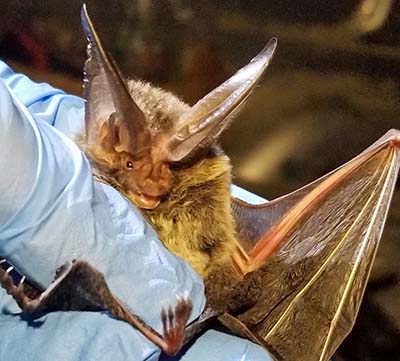(703) 881-3170
Rafinesque’s Big-eared Bat
Rafinesque’s Big-eared Bat Facts
 Photo by Hila TaylorⒸ
Photo by Hila TaylorⒸ
The Rafinesque’s Big-eared Bat can be found in the swamps and bottomland hardwoods (Forest River Swamps) here in Virginia. The can be found near the North Carolina border, and can be found as far north as Lake Anna. Due to loss of habitat from development over the native swamps here in Virginia, the species is under Endangered conservation status. This is being rectified by preserving and enhancing the swamps here in Virginia.
These bats like to roost in the hollows of trees and old buildings. However, those closer to the Appalachians can also be found in caves and mines. However, unlike the other cave dwelling bats in Virginia, their population is not affected by white-nose syndrome, as most prefer to be in the trees rather than caves.
Rafinesque’s Big-eared Bat Characteristics
True to it's name, Rafinesque's Big-eared Bat has ears that is over an inch long, with it's main length as 3.5-4.5 inches long. This bat has brownish gray fur with silver tips on it's belly making it look lighter.
Rafinesque’s Big-eared Bat Mating and Breeding
Mating season starts in the fall through the winter when they are migrating to their winter sites and roosts. After which, females will form maternity colonies. They will give birth in early summer, these bats do not have long gestation periods, but rather has delayed fertilization where they will mat in the fall and will get pregnant in late winter and early spring.
Rafinesque’s Big-eared Bat Diet
a vast majority of the Rafinesque's Big-eared Bat's diet is from moths. Almost 90% of it's diet comes from moths. The rest of it's diet comes from beetles and flying insects.
